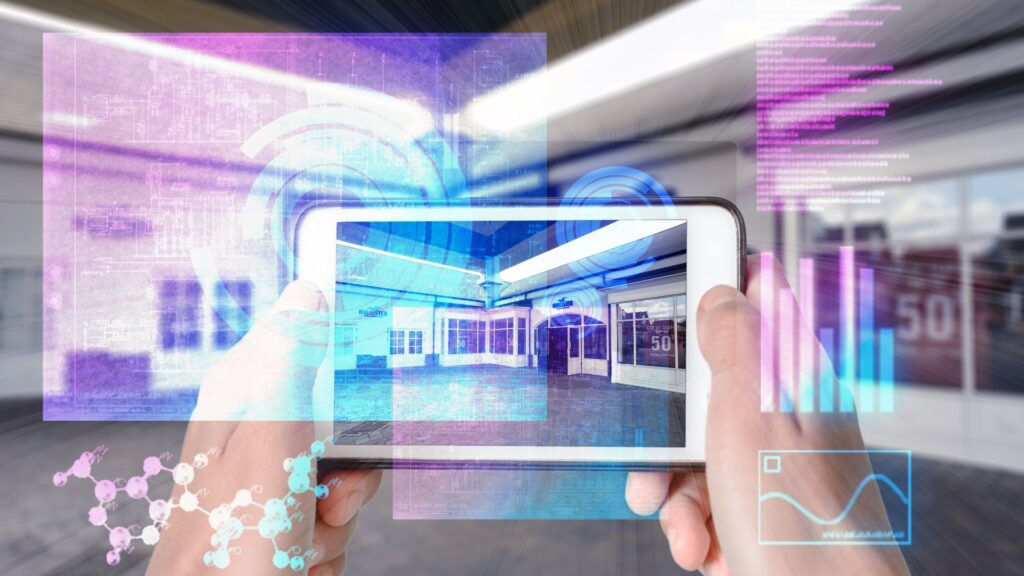Tech Trends and AR
-
Discover
-
Featured
Augmented reality, or AR, is the most recent technological innovation that blends the real world with the virtual world. This 3D interactive experience is accomplished through the use of screen-equipped gadgets, like smartphones and iPads. AR became more widely discussed when the game Pokémon Go was released in 2016, allowing users to “catch em all” by interacting with superimposed Pokemon on their mobile devices. AR is one of the most popular technology trends right now, and will only rise as AR-enabled smartphones, and other gadgets become more available throughout the world.
WHAT ARE THE TYPES OF AUGMENTED REALITY?
Wait, you mean there’s different types of AR? Absolutely! In fact, there are 5 different types of augmented reality. Each type serves a different purpose and allows users to encounter a newer and better natural world in which virtual information is used as a tool to assist with everyday activities.
Read more about each type of AR below:

AR – BASED ON LOCATION
Suppose you’re a traveler looking for an exciting new destination to explore in your area. Location-based AR makes use of the smart device’s location-sensing features. This AR type will leverage your position by reading your smart device’s GPS, compass, and accelerometer, then displaying relevant information on your screen. Google Earth and Google Maps live view are prime examples of this type of augmented reality.

OUTLINING AR
Driving at night can make it difficult to see the lines in the road or the outline of a building. Outline AR assists in recognizing boundaries and borders in moments when the human eye can’t. This method can also be used to outline buildings and their supporting pillars in architecture and engineering.
The line here is a little unclear, though, because outlining AR works with object identification and may appear similar to projection-based AR.

AR-BASED ON RECOGNITION
When you scan a QR code and it pops up with an app or a website, you are using recognition-based AR. This is the AR type that identifies and recognizes an AR marker. It replaces the marker with a related object once it recognizes it.
This is a great way to market your business or product in the physical space because people no longer have to carry around a business card or a pamphlet – they can just scan the marker or code with their mobile device and voila! They can interact with your business, while just going about their day.
Another form of AR technology based on recognition interprets words observed through the camera. This sort of AR, along with the next, appears to be the most largely used.

PROJECTION-BASED AR
This sort of AR, as you might assume, projects digital images on physical items in physical space. It can be interactive, displaying a digital keyboard on your desk or a dialer in your hand. It may also be non-interactive and used to project things that you can position and observe in detail.
Any Marvel fans out there? Iron Man often uses this type of AR to interact with his suit and other mechanical inventions. As this AR technology advances, we may one day have the ability to project silhouettes of people in real-time, as seen in Star Wars films.
The line here is a little unclear, though, because outlining AR works with object identification and may appear similar to projection-based AR.
WHY SHOULD TECH TRENDS CARE ABOUT AUGMENTED REALITY?
AR has advanced beyond gaming and entertainment alone. It has shifted into industries such as healthcare and manufacturing. There is a lot of promise in using this technology to impact your business. Brands will be able to promote themselves and their products in ways social media can’t achieve.
SOME OF THE BENEFITS OF AR INCLUDE:
- Aiding in drawing users’ attention to the products and services that businesses present.
- Inviting clients to take action and engage in the interactions they provide.
- Contributing to the value and popularity of companies and products due to its innovative approach.
- Saving time in the buying experience as well as in day-to-day life activities.
- Saving money, as no extra media tools are required to use AR applications.
AUGMENTED REALITY IMPROVES USER EXPERIENCE
Now that you understand augmented reality, you may be asking why businesses would want to employ it. Listed below are some ways that augmented reality improves user experience and, as a result, business.
Talk with us
EX Squared is a creative technology agency that creates digital products for real human beings.




